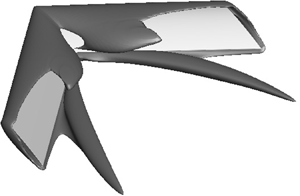Article contents
Laminar separated flows over finite-aspect-ratio swept wings
Published online by Cambridge University Press: 21 October 2020
Abstract

We perform direct numerical simulations of laminar separated flows over finite-aspect-ratio swept wings at a chord-based Reynolds number of  $Re = 400$ to reveal a variety of wake structures generated for a range of aspect ratios (semi aspect ratio
$Re = 400$ to reveal a variety of wake structures generated for a range of aspect ratios (semi aspect ratio  $sAR=0.5\text {--}4$), angles of attack (
$sAR=0.5\text {--}4$), angles of attack ( $\alpha =16^{\circ }\text {--}30^{\circ }$) and sweep angles (
$\alpha =16^{\circ }\text {--}30^{\circ }$) and sweep angles ( $\varLambda =0^{\circ }\text {--}45^{\circ }$). Flows behind swept wings exhibit increased complexity in their dynamical features compared to unswept-wing wakes. For unswept wings, the wake dynamics are predominantly influenced by the tip effects. Steady wakes are mainly limited to low-aspect-ratio wings. Unsteady vortex shedding takes place near the midspan of higher-
$\varLambda =0^{\circ }\text {--}45^{\circ }$). Flows behind swept wings exhibit increased complexity in their dynamical features compared to unswept-wing wakes. For unswept wings, the wake dynamics are predominantly influenced by the tip effects. Steady wakes are mainly limited to low-aspect-ratio wings. Unsteady vortex shedding takes place near the midspan of higher- $AR$ wings due to weakened downwash induced by the tip vortices. With increasing sweep angle, the source of three-dimensionality transitions from the tip to the midspan. The three-dimensional midspan effects are responsible for the formation of the stationary vortical structures at the inboard part of the span, which expands the steady wake region to higher aspect ratios. At higher aspect ratios, the midspan effects of swept wings diminish at the outboard region, allowing unsteady vortex shedding to develop near the tip. In the wakes of highly swept wings, streamwise finger-like structures form repetitively along the wing span, providing a stabilizing effect. The insights revealed from this study can aid the design of high-lift devices and serve as a stepping stone for understanding the complex wake dynamics at higher Reynolds numbers and those generated by unsteady wing manoeuvres.
$AR$ wings due to weakened downwash induced by the tip vortices. With increasing sweep angle, the source of three-dimensionality transitions from the tip to the midspan. The three-dimensional midspan effects are responsible for the formation of the stationary vortical structures at the inboard part of the span, which expands the steady wake region to higher aspect ratios. At higher aspect ratios, the midspan effects of swept wings diminish at the outboard region, allowing unsteady vortex shedding to develop near the tip. In the wakes of highly swept wings, streamwise finger-like structures form repetitively along the wing span, providing a stabilizing effect. The insights revealed from this study can aid the design of high-lift devices and serve as a stepping stone for understanding the complex wake dynamics at higher Reynolds numbers and those generated by unsteady wing manoeuvres.
JFM classification
Information
- Type
- JFM Rapids
- Information
- Copyright
- © The Author(s), 2020. Published by Cambridge University Press
Footnotes
Present address: Department of Mechanical and Aerospace Engineering, Rutgers University.
References
REFERENCES
- 29
- Cited by


